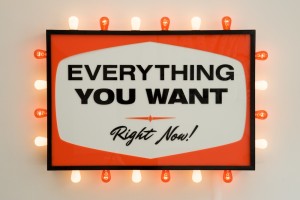- Choice blindness: “Role of ‘narratization,’ the ability of the mind to make a coherent story out what’s happening, with you as the main character, even when it’s clear that the outcome was determined externally.” Interesting writeup with several good links.
- More on attention: “It may be possible to improve your attention by using pulses of light to directly synchronize your neurons.” Yikes! Anyway I’m surprised that so far in the writing about Rapt I haven’t seen mention of Csikszentmihalyi’s “flow” idea. But maybe I haven’t been paying close enough attention.
- Lunch Bag Art: Pretty amazing, no? Via Amy Shaw/ Unconsumption.tumblr.com.
- Mass media helps Web media again.: This item mentions in passing that Twitter has grown *40 percent a week* since Oprah hyped it.
Posted Under:
Non-Daily Linkpile by Rob Walker on May 7, 2009
Comments Off on Linkpile (via Delicious)

Steve Lambert has images & even a video added to his site in connection with his current show in Los Angeles. Cool stuff, check it out here.
Posted Under:
Just Looking,
To Do by Rob Walker on May 6, 2009
Comments Off on Just looking
As mentioned repeatedly: Talk + book signing at NYU’s Blowing Up The Brand, Friday night. Details & RSVP here.
Also: At the end of the 8:20 pm Saturday screening of Objectified at IFC Center, I’ll join director Gary Hustwit for a brief audience Q&A.
Posted Under:
rw,
To Do by Rob Walker on May 6, 2009
Comments Off on Me in NYC: Reminder + new development (won’t mention it again, sorry)
- Attention grabber: Marginal Utility adds another thought to the just-linked Laura Miller essay, addressing the possibilities of “unremembered pleasures.”
- Why can’t we concentrate?: If you can focus long enough to read this, you may learn something. “While it’s one thing to accommodate more information, it’s another to engage with it fundamentally, in a way that allows us to perceive underlying patterns and to take concepts apart so that we can put them back together in new and constructive ways.”
- Studying “The holier-than-thou effect.”: “Long known that people tend to be overly optimistic about their own abilities and fortunes — to overestimate their standing in class, their discipline, their sincerity. But this self-inflating bias may be even stronger when it comes to moral judgment, and it can greatly influence how people judge others’ actions, and ultimately their own.”
- Multi-Platform ‘Mackenzie Blue’ Arrives: Brands mentioned, but author says no paid deals.
- Default Avatars critiqued: By Social Images: Seeing Is Believing.
- Ambivalent Parenting 101: Latest from Adult Education: Brooklyn’s favorite useless lecture series. Tuesday May 5.
Posted Under:
Non-Daily Linkpile by Rob Walker on May 5, 2009
Comments Off on Linkpile (via Delicious)
- YouTube: Placement Police: Cracking down on unauthorized (by YouTube) murketing: “Kevin Nalty, a marketing director at Merck & Co., who produces a series of sophomoric videos on YouTube under the moniker ‘nalts,’ recently received a slightly scary e-mail from YouTube about one of his videos containing brand messaging.” By the way, why is Merck posting “sophomoric” videos? Why does that make sense?
- Wasting Time: Priceless: I don’t disagree, but why is this a Web-specific issue? Same is true of watching TV or looking out the window, no?
- Depression Scares Are Hardly New: Argues that measures suggest three previous periods when there was more fear of a new depression than there is today: 1974/1975, 1978-1982, and 1990-1992. I find this genuinely surprising. In particular I don’t remember any talk of a new depression in 1990-1992 at all — bad economy, yes, but depression talk? That just doesn’t line up with what I can recall.
- Might become a ‘Super Fan’ of a popular movie franchise 4 the rest of my life.: HRO on fandom: “Sort of prefer ‘wasting time on the internet’ because we are all trying to get vulnerable and ’show the world who we are.’”
- Michelle Obama: Sneakerhead: Spotted rocking $540 kicks.
Posted Under:
Non-Daily Linkpile by Rob Walker on May 4, 2009
Comments Off on Linkpile (via Delicious)
 IMMATERIALISM
IMMATERIALISM
With more of life lived online, spending on things that don’t seems more normal.
I’ve actually been scooped by Core77 in posting my own column! Embarrassing. Anyway, Consumed this week is about immaterialism and digital goods — why people buy things that don’t exist.
Consuming things made of bits might sound weird, but actually it offers a lot of the same attractions that make people consume things made of atoms. Facebook’s digital gifting is one relatively mainstream example.
Other examples, and the case for what it all has in common with buying things that do exist, in the full column in the May 3, 2009, issue of The New York Times Magazine, or here.
Discuss, make fun of, or praise this column to the skies at the Consumed Facebook page. For information about writing a letter to the editor, see the FAQ.
Consumed archive is here. The Times‘ Consumed RSS feed is here. Facebook users: Become a Consumed “fan” here.
Posted Under:
Consumed by Rob Walker on May 2, 2009
Comments Off on In The New York Times Magazine: Digital goods
- Discovery, Hasbro Forming Kids’ Network: Come on, this is over the top. “Shows based on Hasbro brands like My Little Pony, G.I. Joe and Scrabble.” Hasbro honcho says part of strategy of “reimagining the potential of our incredible portfolio of brands well beyond traditional toys and games.”
- The revolution that wasn’t: DVRs impact assessed, intelligently, by the Economist.
- Proceed and Be Bold: A Documentary: This looks fantastic! “The biography of an inspiring artist, Amos Paul Kennedy Jr. He quit his corporate job at the age of 40 to follow his dream of becoming a letterpress artist, or as he calls himself, ‘a humble negro printer.'” Link goes to writeup & video trailer.
- steve powers: 2 fists of iron and a bottle of beer: Latest piece of amazement from the artist you may know as ESPO. The Church of the Open Tab, in St.L. This is a (short) video.
Posted Under:
Non-Daily Linkpile by Rob Walker on May 1, 2009
Comments Off on Linkpile (via Delicious)
- General Mills Recruits Bloggers: “MyBlogSpark has recruited more than 900 bloggers — over 80 percent are moms — to register to be eligible for everything from sampling campaigns to product coupons to news of a new ad campaign. General Mills plans to use the network to promote its wide portfolio of products in the food and beverage, beauty, home, electronics, health and automotive categories.”
- Thrifty and bitter?: “56 percent of survey respondents said the recession has caused them to make significant changes in the way they are living. A quarter said they are ‘angry’ or ‘upset’ about having to do so .” Via Recessionwire.com
- Never Mind What It Costs. Can I Get 70 % Off?: The interesting notion that this story suggests but never confronts is whether consumers might actually pay more for something that appears to be more heavily discounted. As in: A widget is on sale for $10, by a sign that says it is 50% off. An identical widget sells for $11, but with a sign that says 80% off. Does the latter sell better because of the advertised markdown percentage? My understanding is that a lot of merchandise is being “discounted” the moment it hits the selling floor now. So could the “original price” be arbitrary in that scenario? (Arbitrary within limits of course.)
- Some Thoughts on Seeing the Film ‘Objectified’: “We had no idea that Rob Walker looked like that.” WTF is that supposed to mean? Like *what*, exactly? Actually I don’t care. I was under the impression that the way I “looked” to UnBeige is invisible. Thought maybe this would be my chance to finally see this site mentioned there — and it didn’t happen. Sad.
Posted Under:
Non-Daily Linkpile by Rob Walker on April 30, 2009
Comments Off on Linkpile (via Delicious)
NOTE (MARCH 25, 2012): I’m not really updating this post anymore. (So I’ve closed the comments.) Please visit RobWalker.net for more about whatever I’m up to now.

EBay

Facebook

Flickr

Hotmail

Twitter

YouTube

Friendfeed
Just a few that occurred to me. More ideas? Let me know.
Or has someone already gathered these up somewhere? It wouldn’t surprise me*, but if it’s out there I couldn’t find it.
UPDATE: I opened the comments, they were closed by mistake. Plus: Adding some more examples after the jump, and will keep adding as they come in or otherwise come to my attention. *2nd UPDATE: On 10.1.09, some has brought to my attention this other collection from 2006. Please continue…
- Blaming advertising: “Two-thirds of Americans (66%) believe advertising agencies have at least some responsibility for the current economic crisis because they caused people to buy things they couldn’t afford. In fact, one-third (33%) believe they have complete or a great deal of responsibility.” Interestingly they tend NOT to blame peers. Which is interesting given years of claims by consumers and gurus alike that advertising doesn’t affect us and we only listen to our friends. But you knew that wasn’t true all along. Didn’t you?
- Ed Hardy wines?: “Perhaps no brand hookup makes less sense. Yet there it was at my local Whole Foods, stacked in orderly end-cap pyramids.” Interesting how Ed Hardy has soldiered on in general. When it debuted, every coolmaking tastemonger I know predicted it would fail immediately. The problem was supposed to be lack of authenticity. Moving into wine wouldn’t seem to help that problem — but maybe it wasn’t a problem after all?
- The fickle Twitterer: “According to a study out today from Nielsen, at least three out of every five people who sign up for a Twitter account bail within a few weeks.” But maybe they come back? I don’t know. Anyway, Nicholas Carr’s take.
- Your Facebook Profile Makes Marketers’ Dreams Come True: Overall not much new here, but an interesting example or two.
- Idiotic lawsuit of the moment: Oprah v. Mutual of Omaha, regarding rights to phrase “aha moment.”
- Obama’s Call to Create, Not Just Consume: “I want us all to think about new and creative ways to engage young people in science and engineering, whether it’s science festivals, robotics competitions, fairs that encourage young people to create and build and invent — to be makers of things, not just consumers of things.”
This is via BB and that makes it “old,” but I can’t take the chance that you may have missed it. Please enjoy, from the auction of Michael Jackson’s … stuff … this painting.
It is, really, some kind of achievement. It is the bad painting to end all bad paintings — and I want it. Thus it is one of the most American things I have ever seen. It is beyond description. It should be turned into a poster and given for free to every household. It speaks for itself.
More MJ acution items, many of which are almost this sublime, here.
- Jobless Tap Power of Merchandising: Someone selling ‘Laid Off Need A Job’ wristbands. Fascinating.
- Autoworkers Compete to Keep Jobs, Livelihoods on New Reality Show: Onion video. Amazingly well-executed.
- Bud Light Product Placement on Facebook: “The beer maker recently released a Bud Light page that features an application that lets users send digital gifts as a part of the company’s ‘Drinkability’ campaign.” Whenever a user sends a virtual Bud Light gift, it appears on the user’s Wall and will be seen by all the recipient’s friends.
- Phantom portraits: Fascinating project “used digital photo manipulation to illustrate the phantom limbs of post-amputation patients.”
- Claim: Affluent Consumers Regain A Bit Of Confidence: “Unity Marketing’s Luxury Consumption Index reports a modest uptick of 1.5 points in their latest survey of affluents (average income of $207,000). While luxury consumers are still cutting back on spending they do feel more optimistic about the future of both their personal finances and the country’s economic recovery. Many of the 1,034 people surveyed said they see a recovery coming within the next twelve months.”
- How Susan Boyle Spread and What It Means: “While she originated on British broadcast television, her entry into the American market was shaped more by the conscious decisions of 87 plus million people who choose to pass her video along … than by any decision by network executives to put her on the airwaves in the first place.” Well, sort of. How many people actually had this video “passed along” to them, as opposed to heard about it from a media source — a category that I would say includes prominent/popular blogs — and then either Googled it up, or clicked through? I would guess a LOT of the views came from the latter scenario, especially as this became such a prominent media story. I certainly think that X million views does NOT equal X million people “choosing to pass [the video] along” to someone else. The distinction matters in this context because of the argument being made about spreadability.




 "
"

 IMMATERIALISM
IMMATERIALISM

















 Kim Fellner's book
Kim Fellner's book  A
A